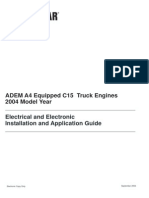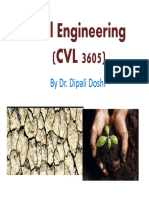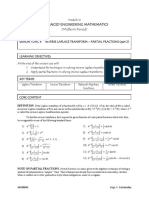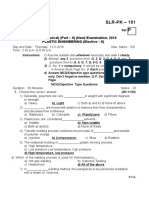GTEL01E: Physical Properties of Soil: Modules in
Uploaded by
HatsuieeGTEL01E: Physical Properties of Soil: Modules in
Uploaded by
Hatsuiee1
Modules in
GTEL01E: Physical Properties of Soil
SESSION TOPIC 2: Physical Properties of Soil
LEARNING OBJECTIVES:
After the lecture, the students must be able to:
1. Define the properties of soil and examine its fundamental principles.
2. Solve the problems about the soil properties.
KEY TERMS
Soil Water Content Void Ratio Specific Gravity
Porosity Degree of Saturation Unit Weight Phase Diagram of
soil
CORE CONTENT
Phase Diagram of Soil
Soil is composed of solids, liquids, and gases. Liquids and gases are mostly water and air,
respectively. These two (water and air) are called voids which occupy between soil particles.
The figure shown below is an idealized soil drawn into phases of solids, water, and air.
Prepared By: Engr. C. Zapanta Jr.
2
Weight-Volume Relationship from the Phase Diagram
Total volume = Volume of soilds + Volume of voids
V = Vs+Vv
Volume of voids = Volume of water + Volume of air
Vv = Vw+Va
Total weight = Weight of solids + Weight of water
W = Ws+Ww
Soil Properties
Void Ratio, e
Void ratio is the ratio of volume of voids to the volume of solids.
Porosity, n
Porosity is the ratio of volume of voids to the total volume of soil.
Degree of Saturation, S
Degree of saturation is the ratio of volume of water to the volume of voids.
Water Content or Moisture Content, w
Moisture content, usually expressed in terms of percentage, is the ratio of the weight of water to
the weight of solids.
Prepared By: Engr. C. Zapanta Jr.
3
Unit Weight, γ
Unit weight is the weight of soil per unit volume. Also called bulk unit weight (γ), and moist unit
weight (γm).
Dry Unit Weight, γd
Dry unit weight is the weight of dry soil per unit volume.
Saturated Unit Weight, γsat
Saturated unit weight is the weight of saturated soil per unit volume.
Effective Unit Weight, γ'
Effective unit weight is the weight of solids in a submerged soil per unit volume. Also called
buoyant density or buoyant unit weight (γb).
Specific Gravity of Solid Particles, G
Specific gravity of solid particles of soil is the ratio of the unit weight of solids (γs) to the unit
weight of water (γw).
Prepared By: Engr. C. Zapanta Jr.
4
Formulas for Properties of Soil
Prepared By: Engr. C. Zapanta Jr.
5
Prepared By: Engr. C. Zapanta Jr.
6
Relationship between G, w, S, and e
The relationship between specific gravity of solid particles G, water content or moisture content
w, degree of saturation S, and void ratio e, is given by the following:
Relationship between e and n
The relationship between the the void ratio e, and the porosity n is given by:
Prepared By: Engr. C. Zapanta Jr.
7
Consistency of Soil (Atterberg Limits)
Consistency is the term used to describe the ability of the soil to resist rupture and deformation.
It is commonly describe as soft, stiff or firm, and hard.
Water content greatly affects the engineering behavior of fine-grained soils. In the order of
increasing moisture content, a dry soil will exist into four distinct states: from solid state, to
semisolid state, to plastic state, and to liquid state. The water contents at the boundary of these
states are known as Atterberg limits. Between the solid and semisolid states is shrinkage limit,
between semisolid and plastic states is plastic limit, and between plastic and liquid states is
liquid limit.
Atterberg limits, then, are water contents at critical stages of soil behavior. They, together with
natural water content, are essential descriptions of fine-grained soils.
Liquid Limit, LL
Liquid limit is the water content of soil in which soil grains are separated by water just enough
for the soil mass to loss shear strength. A little higher than this water content will tend the soil to
flow like viscous fluid while a little lower will cause the soil to behave as plastic.
Prepared By: Engr. C. Zapanta Jr.
8
Plastic Limit, PL
Plastic limit is the water content in which the soil will pass from plastic state to semi-solid state.
Soil can no longer behave as plastic; any change in shape will cause the soil to show visible
cracks.
Shrinkage Limit, SL
Shrinkage limit is the water content in which the soil no longer changes in volume regardless of
further drying. It is the lowest water content possible for the soil to be completely saturated. Any
lower than the shrinkage limit will cause the water to be partially saturated. This is the point in
which soil will pass from semi-solid to solid state.
Determination of Liquid, Plastic, and Shrinkage Limits:
Casagrande Cup Method for Liquid Limit Test
The semispherical brass cup is repeatedly dropped into a hard rubber base from a height of 10
mm by a cam-operated crank.
Prepared By: Engr. C. Zapanta Jr.
9
The dry powder of the soil is mixed with distilled water turning it into a paste. The soil paste is
then placed into the cup to a thickness of about 12.5 mm and a groove is then cut at the center
of the paste using the standard grooving tool. The crank operating the cam is turned at the rate
of 2 revolutions per second lifting the cup and dropped it from a height of 10 mm. The liquid limit
is the moisture content required to close a distance of 12.5 mm along the bottom of the groove
after 25 blows.
The required closure in 25 blows is difficult to achieve in a single test. Four or more tests to the
same soil at varying water contents are to be done for 12.5 mm closure of the groove. The
results are then plotted on a semi-logarithmic graph with moisture content along the vertical axis
(algebraic scale) and number of blows along the horizontal axis (logarithmic scale).
The graph is approximated by the best fit straight line, usually called the flow line and
sometimes called liquid state line. The moisture content that corresponds to 25 blows is the
liquid limit of the soil.
Prepared By: Engr. C. Zapanta Jr.
10
The slope of the flow line is called flow index and may be written as:
where w1 and w2 are the water content corresponding to number of blows N1 and N2,
respectively.
Shrinkage Limit Test
The shrinkage limit is determined as follows. A mass of wet soil, m1, is placed in a porcelain dish
44.5 mm in diameter and 12.5 mm high and then oven dried. With oven-dried soil still in the
dish, the volume of shrinkage can be determined by filling the dish with mercury. The volume of
mercury that fills the dish is equal to the shrinkage volume. The shrinkage limit is calculated
from.
where m1 = mass of wet soil, m2 = mass of oven-dried soil, V1 = volume of wet soil, V2 =
volume of oven-dried soil, and ρw = density of water.
Other Formulas:
Shrinkage ratio:
Specific gravity of solids:
Prepared By: Engr. C. Zapanta Jr.
11
Formulas for Densities of Soil
The terms density and unit weight are used interchangeably in soil mechanics. Though not
critical, it is important that we know it. To find the formula for density, divide the formula of unit
weight by gravitational constant g (acceleration due to gravity). But instead of having g in the
formula, use the density of water replacing the unit weight of water.
Basic formula for density (note: m = W/g)
The following formulas are taken from unit weights of soil:
Density of water and gravitational constant
ρw = 1000 kg/m3
ρw = 1 g/cc
ρw = 62.4 lb/ft3
g = 9.81 m/s2 = 32.2 ft/sec2
Prepared By: Engr. C. Zapanta Jr.
12
Relative Density
Relative density is an index that quantifies the state of compactness between the loosest and
densest possible state of coarse-grained soils.
The relative density is written in the following formulas:
where:
Dr = relative density
e = current void ratio of the soil in-situ
emax = void ratio of the soil at its loosest condition
emin = void ratio of the soil at its densest condition
γd = current dry unit weight of soil in-situ
(γd)min = dry unit weight of the soil at its loosest condition
(γd)max = dry unit weight of the soil at its densest condition
Designation of Granular Soil Based on Relative Density
Prepared By: Engr. C. Zapanta Jr.
13
IN-TEXT ACTIVITY
Attachments:
PDF Lecture/slides – Fundamental Concepts
Multi-media:
Video/ Audio (prerecorded) materials
SESSION SUMMARY
Important points:
Soil properties. All soils contain mineral particles, organic matter, water and air. The
combinations of these determine the soil's properties – its texture, structure, porosity, chemistry
and colour. Soil is made up of different-sized particles.
SELF ASSESSMENT
ACTIVITY 2
Soil Properites
Name: ________________ SCORE: ______________
Major: ________________ Date: ________________
1.) The mass of a sample of saturated soil is 520g. The dry mass, after oven drying is 405g.
Assuming G = 2.7, calculate the effective unit weight of the soil mass, in kN/cu.m?
2.) In its natural state, a moist soil has a volume of 9350 cc and weighs 18kg. The oven dried
weight of the soil is 15.54kg. Use Gs = 2.67.
A.) Determine the moisture content in percent.
B.) Determine the void ratio in percent.
C.) Determine the degree of saturation in percent.
3.) A cubic meter of soil in its natural state weighs17.5kN. After oven drying the soil weighs
14.2kN. Assume G = 2.7
A.) Calculate the void ratio of the soil.
B.) Calculate the degree saturation of the soil.
C.) Calculate the saturated density of the soil in kN/cu.m
Prepared By: Engr. C. Zapanta Jr.
14
REFERENCES
Bessavilla. Fundamentals of Geotechnical Engineering.
Das, Braja M. Principles of Geotechnical Engineering. 5th Edition
Prepared By: Engr. C. Zapanta Jr.
You might also like
- ADEM A4 Equipped C15 Truck Engines - Electrical and Electronic Installation and Application Guide - CATERPILLAR PDF100% (13)ADEM A4 Equipped C15 Truck Engines - Electrical and Electronic Installation and Application Guide - CATERPILLAR PDF229 pages
- Foundation Plan: Technological Institute of The Philippines Project Title: Proposed Five Storey Commercial BuildingNo ratings yetFoundation Plan: Technological Institute of The Philippines Project Title: Proposed Five Storey Commercial Building1 page
- Geometric Design of Highway Facilities: Lecture 6 Hgen01E/Hren01E DrexsibalNo ratings yetGeometric Design of Highway Facilities: Lecture 6 Hgen01E/Hren01E Drexsibal28 pages
- 4.) RCD - Midterm Library Work Quiz - Concept and Solutions (1-Way Slab)100% (1)4.) RCD - Midterm Library Work Quiz - Concept and Solutions (1-Way Slab)8 pages
- Lecture 4 Index properties of soil (part 1)No ratings yetLecture 4 Index properties of soil (part 1)32 pages
- Chapter 9:uniform Flow in Mobile Boundary ChannelNo ratings yetChapter 9:uniform Flow in Mobile Boundary Channel32 pages
- CE 4115 - Principles of Reinforced/Pre-stressed Concrete: Romblon State UniversityNo ratings yetCE 4115 - Principles of Reinforced/Pre-stressed Concrete: Romblon State University7 pages
- PROFFESIONALINTEGRATIONIdifferentialcalculusNo ratings yetPROFFESIONALINTEGRATIONIdifferentialcalculus2 pages
- Complex Trusses Complex Trusses: S S' + XsNo ratings yetComplex Trusses Complex Trusses: S S' + Xs3 pages
- I Have Chosen This Topic So That I Can Test The Strength and Behaviour of SFRSCNo ratings yetI Have Chosen This Topic So That I Can Test The Strength and Behaviour of SFRSC3 pages
- Chapter 2 Part 2 - Deflection Unit Load Method 2017No ratings yetChapter 2 Part 2 - Deflection Unit Load Method 201753 pages
- Syllabus OBE CDIO Format Specialized413B JCCNo ratings yetSyllabus OBE CDIO Format Specialized413B JCC9 pages
- Assignment 1 - Historical Background and Early Fathers On Structural Engineering PDFNo ratings yetAssignment 1 - Historical Background and Early Fathers On Structural Engineering PDF8 pages
- 5 - Three Moment Equation For Continuous BeamNo ratings yet5 - Three Moment Equation For Continuous Beam19 pages
- New Format For ACCRE Level 4-CE CORRELATIONNo ratings yetNew Format For ACCRE Level 4-CE CORRELATION8 pages
- Student Outcomes (Sos) Addressed by The Activity: Mechanics of Fluid Laboratory ManualNo ratings yetStudent Outcomes (Sos) Addressed by The Activity: Mechanics of Fluid Laboratory Manual10 pages
- CEPE 3S Earthquake Loads Example ProblemNo ratings yetCEPE 3S Earthquake Loads Example Problem16 pages
- CE131P - 2 DEFLECTIONS BY Castiglianos TheoremNo ratings yetCE131P - 2 DEFLECTIONS BY Castiglianos Theorem21 pages
- Numerical Methods and Implementation in Geotechnical Engineering – Part 1From EverandNumerical Methods and Implementation in Geotechnical Engineering – Part 1No ratings yet
- Chapter 3 - Physical Properties of SoilNo ratings yetChapter 3 - Physical Properties of Soil50 pages
- 1 Geotechnical Eng G Besavilla Pages 1 245No ratings yet1 Geotechnical Eng G Besavilla Pages 1 245142 pages
- Classification of Engineering Services: Engr. Anjerick TopacioNo ratings yetClassification of Engineering Services: Engr. Anjerick Topacio55 pages
- Principles of Reinforced and Prestressed Concrete: Module inNo ratings yetPrinciples of Reinforced and Prestressed Concrete: Module in46 pages
- 1 Geotechnical Eng G Besavilla Pages 1 245No ratings yet1 Geotechnical Eng G Besavilla Pages 1 245142 pages
- Advanced Engineering Mathematics (Prelim Period) : Module inNo ratings yetAdvanced Engineering Mathematics (Prelim Period) : Module in13 pages
- Advanced Engineering Mathematics (Prelim Period) : Module inNo ratings yetAdvanced Engineering Mathematics (Prelim Period) : Module in12 pages
- Truncation Errors and The Taylor Series: Engr. Aure Flo A. Oraya, MSCENo ratings yetTruncation Errors and The Taylor Series: Engr. Aure Flo A. Oraya, MSCE29 pages
- 1-Behavioural, Social and Administrative Pharmacy Practice (Pharmacy Management) AnswersNo ratings yet1-Behavioural, Social and Administrative Pharmacy Practice (Pharmacy Management) Answers13 pages
- Palm Vitamin E Tocotrienols Neurodegenerative Diseases P1 DR Yuen Kah HayNo ratings yetPalm Vitamin E Tocotrienols Neurodegenerative Diseases P1 DR Yuen Kah Hay32 pages
- Grade Control Techniques at Paddington Gold MineNo ratings yetGrade Control Techniques at Paddington Gold Mine14 pages
- Printable-Spice-Baking-Pantry-Staples-Lists-1No ratings yetPrintable-Spice-Baking-Pantry-Staples-Lists-15 pages
- Introductory Reading For Medicine - Rev 2021No ratings yetIntroductory Reading For Medicine - Rev 20212 pages
- (eBook PDF) Empowerment Series: Introduction to Social Work and Social Welfare: Empowering People 12th Edition instant download100% (7)(eBook PDF) Empowerment Series: Introduction to Social Work and Social Welfare: Empowering People 12th Edition instant download52 pages
- Studies of Phenotypic and Genotypic Variation in Sixteen Cucumber GenotypesNo ratings yetStudies of Phenotypic and Genotypic Variation in Sixteen Cucumber Genotypes7 pages
- ADEM A4 Equipped C15 Truck Engines - Electrical and Electronic Installation and Application Guide - CATERPILLAR PDFADEM A4 Equipped C15 Truck Engines - Electrical and Electronic Installation and Application Guide - CATERPILLAR PDF
- Foundation Plan: Technological Institute of The Philippines Project Title: Proposed Five Storey Commercial BuildingFoundation Plan: Technological Institute of The Philippines Project Title: Proposed Five Storey Commercial Building
- Geometric Design of Highway Facilities: Lecture 6 Hgen01E/Hren01E DrexsibalGeometric Design of Highway Facilities: Lecture 6 Hgen01E/Hren01E Drexsibal
- 4.) RCD - Midterm Library Work Quiz - Concept and Solutions (1-Way Slab)4.) RCD - Midterm Library Work Quiz - Concept and Solutions (1-Way Slab)
- CE 4115 - Principles of Reinforced/Pre-stressed Concrete: Romblon State UniversityCE 4115 - Principles of Reinforced/Pre-stressed Concrete: Romblon State University
- I Have Chosen This Topic So That I Can Test The Strength and Behaviour of SFRSCI Have Chosen This Topic So That I Can Test The Strength and Behaviour of SFRSC
- Chapter 2 Part 2 - Deflection Unit Load Method 2017Chapter 2 Part 2 - Deflection Unit Load Method 2017
- Assignment 1 - Historical Background and Early Fathers On Structural Engineering PDFAssignment 1 - Historical Background and Early Fathers On Structural Engineering PDF
- Student Outcomes (Sos) Addressed by The Activity: Mechanics of Fluid Laboratory ManualStudent Outcomes (Sos) Addressed by The Activity: Mechanics of Fluid Laboratory Manual
- Numerical Methods and Implementation in Geotechnical Engineering – Part 1From EverandNumerical Methods and Implementation in Geotechnical Engineering – Part 1
- Classification of Engineering Services: Engr. Anjerick TopacioClassification of Engineering Services: Engr. Anjerick Topacio
- Principles of Reinforced and Prestressed Concrete: Module inPrinciples of Reinforced and Prestressed Concrete: Module in
- Advanced Engineering Mathematics (Prelim Period) : Module inAdvanced Engineering Mathematics (Prelim Period) : Module in
- Advanced Engineering Mathematics (Prelim Period) : Module inAdvanced Engineering Mathematics (Prelim Period) : Module in
- Truncation Errors and The Taylor Series: Engr. Aure Flo A. Oraya, MSCETruncation Errors and The Taylor Series: Engr. Aure Flo A. Oraya, MSCE
- 1-Behavioural, Social and Administrative Pharmacy Practice (Pharmacy Management) Answers1-Behavioural, Social and Administrative Pharmacy Practice (Pharmacy Management) Answers
- Palm Vitamin E Tocotrienols Neurodegenerative Diseases P1 DR Yuen Kah HayPalm Vitamin E Tocotrienols Neurodegenerative Diseases P1 DR Yuen Kah Hay
- (eBook PDF) Empowerment Series: Introduction to Social Work and Social Welfare: Empowering People 12th Edition instant download(eBook PDF) Empowerment Series: Introduction to Social Work and Social Welfare: Empowering People 12th Edition instant download
- Studies of Phenotypic and Genotypic Variation in Sixteen Cucumber GenotypesStudies of Phenotypic and Genotypic Variation in Sixteen Cucumber Genotypes






































































































